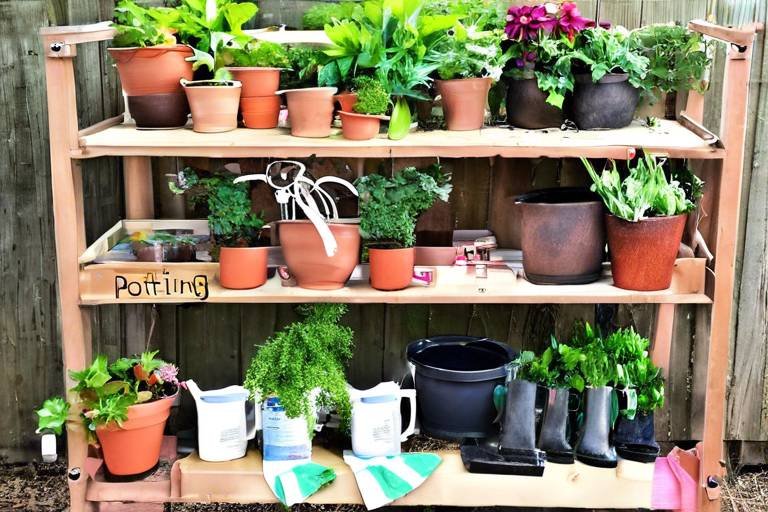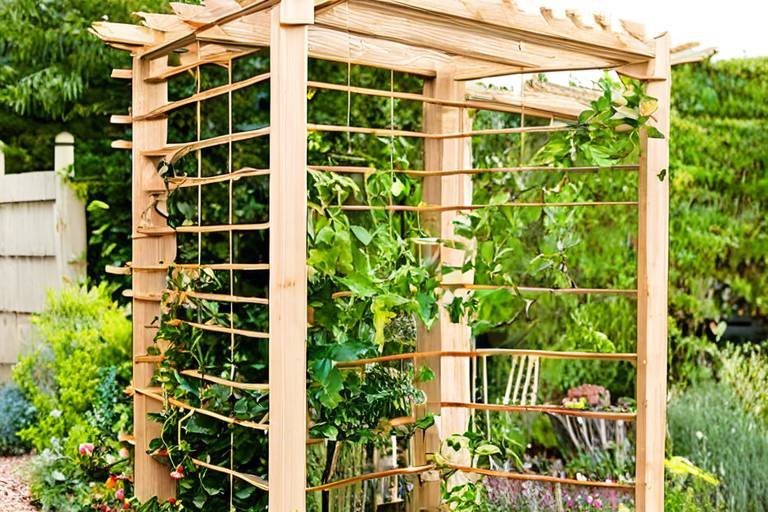Best Tips for Growing Radishes in Your Garden
Ravishing radishes, the jewels of the garden that add a burst of color and flavor to your plate. Growing these vibrant veggies is a rewarding experience for any gardener, whether you're a novice or a seasoned pro. Let's dive into the best tips for cultivating radishes in your garden, from selecting the right variety to savoring the freshly harvested roots.

Choosing the Right Variety
When it comes to choosing the right variety of radishes for your garden, there are several factors to consider to ensure a successful harvest. The first step is to determine your climate and growing conditions, as different radish varieties thrive in various environments. For instance, round red radishes are popular for their quick growth and vibrant color, while long white radishes are known for their mild flavor and elongated shape.
Additionally, consider your personal preference when selecting a radish variety. Are you looking for a spicy kick to add to salads and dishes, or do you prefer a milder taste for snacking? Understanding your taste preferences will help you choose the perfect radish variety that suits your culinary needs.
It's also essential to take into account the growing requirements of each radish variety. Some types may prefer cooler temperatures, while others can tolerate heat better. By selecting a variety that aligns with your climate and growing conditions, you can set yourself up for a bountiful radish harvest.
Furthermore, think about the intended use of your radishes. Are you planning to enjoy them fresh in salads, pickle them for a tangy crunch, or incorporate them into various dishes? Different radish varieties offer unique flavors and textures that can enhance your culinary creations, so choose a variety that complements your cooking style.
Lastly, don't be afraid to experiment with different radish varieties in your garden. Planting a mix of round, long, and specialty radishes can add visual interest and diversity to your harvest. By selecting a range of varieties, you can enjoy a rainbow of colors and flavors in your radish patch, making each harvest a delightful surprise.

Preparing the Soil
When it comes to growing radishes successfully, preparing the soil is a crucial step that can significantly impact the quality of your harvest. Radishes prefer loose, well-draining soil that is rich in organic matter, providing them with the ideal environment to develop healthy roots and vibrant foliage.
Start by selecting a sunny spot in your garden for planting radishes. Before sowing the seeds, it's essential to prepare the soil properly to ensure optimal growth. Begin by loosening the soil to a depth of at least 6-8 inches using a garden fork or tiller. This loosening process helps improve soil aeration and allows the radish roots to penetrate easily.
Adding compost or well-rotted manure to the soil can enhance its fertility and provide essential nutrients for the radishes. Mix the organic matter thoroughly into the soil to ensure an even distribution of nutrients. Additionally, incorporating a balanced fertilizer with a higher phosphorus content can promote root development and overall plant growth.
Proper drainage is key to preventing waterlogged soil, which can lead to rotting roots and stunted growth. If your garden bed has poor drainage, consider amending the soil with sand or perlite to improve its structure and prevent water accumulation.
Before planting radish seeds, perform a soil pH test to ensure it falls within the optimal range of 6.0-7.0. Adjust the pH level if necessary by adding lime to raise the pH or sulfur to lower it. Maintaining the correct soil pH is essential for nutrient uptake and overall plant health.
Remember to avoid compacting the soil by walking on it excessively, as this can hinder root growth and nutrient absorption. Once the soil preparation is complete, you're ready to sow your radish seeds and embark on a rewarding gardening journey filled with crisp, flavorful radishes.

Planting and Spacing
Radishes are easy-to-grow vegetables that are perfect for beginner gardeners. This article provides essential tips for successfully cultivating radishes in your garden, from soil preparation to harvesting techniques.
Selecting the appropriate radish variety based on your climate and preference is crucial for a successful harvest. Different types, such as round red radishes or long white radishes, have varying growing requirements.
Radishes thrive in well-draining, loose soil with plenty of organic matter. Learn how to prepare your garden bed by loosening the soil, amending with compost, and ensuring proper drainage for optimal growth.
When it comes to planting radishes, spacing is key. Giving each seed enough room to grow ensures healthy root development and prevents overcrowding. The ideal spacing between radish plants is typically around 2-3 inches apart. This allows the roots to expand and develop properly without competition.
Additionally, planting depth is important. Radish seeds should be sown about half an inch deep in the soil. This depth provides the seeds with the right conditions to germinate and grow into healthy plants. Timing is also crucial for successful radish cultivation. Planting in early spring or fall when temperatures are cooler can result in better yields.
Understand the watering needs of radishes throughout their growth stages and learn how to fertilize them appropriately for robust foliage and plump roots. Overwatering or over-fertilizing can lead to issues like splitting roots.
Identify common pests and diseases that can affect radishes, such as flea beetles and root maggots, and learn organic methods to prevent and control infestations. Proper garden hygiene can also help minimize disease risks.
Learn the importance of thinning radish seedlings to prevent overcrowding and ensure adequate root development. Regular weeding is crucial to reduce competition for nutrients and sunlight, promoting healthy radish growth.
Discover the signs that indicate radishes are ready for harvest, such as proper size and color, and learn how to harvest them without damaging the roots. Freshly harvested radishes offer the best flavor and texture.
Explore different methods for storing harvested radishes to maintain their freshness and crispness. Additionally, get creative recipe ideas for incorporating radishes into salads, pickles, and other dishes to enjoy your homegrown produce.
Have more questions about growing radishes in your garden? Check out some common FAQs below:
Q: How long does it take for radishes to grow?
A: Radishes typically mature in about 3-4 weeks after planting, depending on the variety and growing conditions.
Q: Can radishes be grown in containers?
A: Yes, radishes can be successfully grown in containers as long as they have enough space for root development and receive adequate sunlight.
Q: What is the best time of day to water radishes?
A: Water radishes in the morning to allow foliage to dry before evening, reducing the risk of disease.

Watering and Fertilizing
Proper watering and fertilizing are essential aspects of cultivating healthy and vibrant radishes. These practices play a significant role in ensuring robust foliage growth and the development of plump, flavorful roots.
When it comes to watering radishes, consistency is key. Radishes require regular watering to maintain moist soil conditions, especially during hot and dry periods. However, overwatering can lead to issues like root rot, so it's crucial to find the right balance.
One effective method to ensure adequate moisture for radishes is to water deeply but infrequently. This encourages the roots to grow deeper into the soil in search of water, promoting overall plant health and stability.
Additionally, fertilizing radishes with a balanced fertilizer can provide the necessary nutrients for optimal growth. A fertilizer with a higher phosphorus content is beneficial for root development, while adequate nitrogen supports leafy growth.
Before planting radish seeds, incorporating organic matter such as compost into the soil can help provide a nutrient-rich environment for the plants. This organic material acts as a natural fertilizer, promoting healthy growth without the risk of chemical buildup.
Remember to monitor your radishes regularly to assess their growth and adjust your watering and fertilizing routine accordingly. By paying attention to these crucial aspects, you can ensure a bountiful harvest of delicious radishes from your garden.

Managing Pests and Diseases
Managing pests and diseases is a critical aspect of cultivating healthy radishes in your garden. These pesky invaders can wreak havoc on your radish crop if left unchecked. One common pest to watch out for is the flea beetle, which can cause significant damage to radish leaves by creating small holes. To combat flea beetles organically, consider using floating row covers to protect your plants or applying a neem oil solution as a natural deterrent.
Another potential threat to your radishes is the root maggot, a tiny fly whose larvae feed on radish roots, causing stunted growth and poor yields. To prevent root maggot infestations, practice crop rotation by avoiding planting radishes in the same spot year after year. Additionally, incorporating beneficial nematodes into the soil can help control root maggot populations effectively.
When it comes to diseases, radishes are susceptible to issues like damping-off, a fungal disease that can kill seedlings before they have a chance to grow. To prevent damping-off, ensure proper air circulation around your plants by spacing them adequately and avoiding overwatering. Using a sterile seed-starting mix can also reduce the risk of fungal infections.
One effective method for managing both pests and diseases is practicing good garden hygiene. Remove any plant debris or weeds that could harbor pests or pathogens, and regularly inspect your radish plants for early signs of trouble. By staying vigilant and taking proactive measures, you can protect your radish crop and ensure a bountiful harvest.

Thinning and Weeding
When it comes to growing radishes in your garden, thinning and weeding are essential tasks to ensure the healthy development of your radish plants. Thinning refers to the process of removing excess seedlings to provide ample space for the remaining plants to grow without overcrowding. This practice allows each radish plant to access sufficient nutrients and sunlight, promoting robust root development and preventing stunted growth.
On the other hand, weeding is crucial to eliminate competing plants that can deprive radishes of essential resources. Weeds not only compete for nutrients and water but also create shade, hindering the growth of radish plants. Regular weeding helps maintain a clean and tidy garden bed, reducing the risk of pest infestations and diseases that thrive in unkempt environments.
One effective method for thinning radish seedlings is to gently pull out the weaker or excess plants, leaving adequate space between the remaining seedlings. Aim for a spacing of about 2-3 inches between each radish plant to allow room for proper root expansion. Overcrowded plants can lead to small, misshapen roots, affecting the overall quality of your radish harvest.
When it comes to weeding, manual removal is often the best approach, especially in the early stages of radish growth. Use a hand tool or simply pull out weeds by hand, being careful not to disturb the radish plants. Mulching around radish rows can also help suppress weed growth and retain soil moisture, reducing the need for frequent weeding.
By incorporating regular thinning and weeding practices into your radish cultivation routine, you can create an optimal growing environment for your plants to thrive. These simple yet crucial tasks contribute to healthy root development, vigorous growth, and ultimately, a bountiful harvest of delicious radishes from your garden.

Harvesting at the Right Time
Harvesting radishes at the right time is crucial to enjoy their optimal flavor and texture. When radishes reach the appropriate size and color, it's time to harvest them to ensure they are at their peak. Typically, radishes are ready for harvest around 3-4 weeks after planting, but this can vary depending on the variety and growing conditions.
One indicator that radishes are ready for harvest is their size. Most varieties should reach about 1 inch in diameter, but this can vary, so refer to the specific guidelines for the type you are growing. Additionally, the color of the radish should be vibrant and uniform, indicating maturity.
When harvesting radishes, gently loosen the soil around the base of the plant to avoid damaging the roots. Grasp the leaves near the root and pull the radish out gently. If the radish resists, use a garden fork to loosen the soil further to prevent breakage.
After harvesting, remove the tops of the radishes, leaving about an inch of the stem attached. This helps prolong the freshness of the radishes when storing them. Store harvested radishes in the refrigerator in a perforated plastic bag to maintain their crispness and flavor.
If you prefer a continuous harvest, consider planting radishes in succession every 1-2 weeks. This way, you can enjoy a steady supply of fresh radishes throughout the growing season.

Storing and Using Radishes
When it comes to storing and using radishes, there are a few key tips to keep in mind to ensure you get the most out of your harvest. After putting in the effort to grow these vibrant vegetables, you'll want to store them properly to maintain their freshness and crunch. Radishes can be quite versatile in the kitchen, adding a peppery kick to salads, sandwiches, and even pickles.
One method for storing radishes is to remove the leafy greens, as they can draw moisture away from the roots and cause them to become soft. After trimming the greens, you can store radishes in the refrigerator. Placing them in a perforated plastic bag or a container with a damp paper towel can help maintain their crisp texture for longer.
If you have an abundance of radishes, consider pickling them to enjoy their unique flavor throughout the year. Pickled radishes can add a tangy and colorful element to dishes, enhancing both the taste and presentation. Experiment with different pickling spices and methods to find your favorite combination.
When incorporating radishes into salads, consider slicing them thinly for a delicate crunch or grating them for a more subtle texture. Their vibrant color can brighten up any dish, adding visual appeal along with a refreshing taste. Radishes can also be roasted or sautéed to bring out their natural sweetness and mellow their sharpness.
For a quick and easy snack, try spreading cream cheese on a slice of crusty bread and topping it with thinly sliced radishes and a sprinkle of sea salt. This simple yet delicious combination highlights the radish's peppery flavor while providing a satisfying crunch.
Whether you enjoy radishes raw, cooked, or pickled, their versatility makes them a valuable addition to any kitchen. Get creative with your recipes and explore different ways to incorporate these vibrant vegetables into your meals for a fresh and flavorful experience.
Frequently Asked Questions
- Can I grow radishes in containers?
Absolutely! Radishes can thrive in containers as long as they have enough space for root development and receive adequate sunlight. Make sure the container has proper drainage to prevent waterlogging.
- How often should I water my radishes?
Radishes prefer consistent moisture, so it's essential to water them regularly, especially during dry periods. However, be cautious not to overwater, as it can lead to issues like rotting roots.
- What is the best time to harvest radishes?
Radishes are typically ready to harvest within 3-4 weeks after planting. The best time to harvest is when they reach the desired size and color, usually indicated on the seed packet or variety information.
- How can I prevent pests from damaging my radishes?
Implementing companion planting with natural pest repellents like marigolds or using row covers can help deter pests. Regularly inspecting your plants for signs of infestation and taking prompt action is key to preventing damage.



















